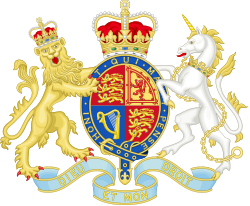George Brown, Baron George-Brown
George Alfred Brown, Baron George-Brown (* 2. September 1914; † 2. Juni 1985 in Truro, Cornwall) war ein britischer Politiker.
Karriere
Brown war Mitglied des Unterhauses der Labour Party, deren stellvertretender Vorsitzender er von 1960 bis 1968 war, für den Bezirk Belper in der Grafschaft Derbyshire von 1945 bis 1970, kurzzeitig Arbeitsminister (1951) und Außenminister von 1966 bis 1968.
Im Jahr 1963 kandidierte er nach dem Tod von Hugh Gaitskell für den Parteivorsitz, unterlag jedoch Harold Wilson. Der hochrangige Labour-Politiker Anthony Crosland bezeichnete die interne Entscheidung zwischen Wilson und Brown als Wahl „zwischen einem Gauner und einem Säufer“ (Brown wurde ein Alkoholproblem nachgesagt).[1]
Am 6. November 1970 wurde er als Baron George-Brown, of Jevington in the County of Sussex, zum Life Peer und wurde dadurch auf Lebenszeit Mitglied des House of Lords.[2] Nach seinem Tod in Cornwall wurde er im Golders Green Crematorium in London eingeäschert, wo sich auch seine Asche befindet.
Bibliografie
- In My Way (Autobiographie)
Einzelnachweise
- ↑ Andrew Marr: A History of Modern Britain. Macmillan, London 2007, ISBN 978-1-4050-0538-8, S. 236 Original: a choice between a crook and a drunk.
- ↑ The London Gazette: Nr. 45229, S. 12333, 10. November 1970.
| Personendaten | |
|---|---|
| NAME | Brown, George, Baron George-Brown |
| ALTERNATIVNAMEN | Brown, George Alfred |
| KURZBESCHREIBUNG | britischer Politiker |
| GEBURTSDATUM | 2. September 1914 |
| STERBEDATUM | 2. Juni 1985 |
| STERBEORT | Truro, Cornwall |
Auf dieser Seite verwendete Medien
Flagge des Vereinigten Königreichs in der Proportion 3:5, ausschließlich an Land verwendet. Auf See beträgt das richtige Verhältnis 1:2.
Autor/Urheber: Kroon, Ron / Anefo; Nationaal Archief (NL), Filenumber 920-1152, Lizenz: CC0
George Brown
Autor/Urheber: Sodacan, Lizenz: CC BY-SA 3.0
Royal Coat of Arms of the United Kingdom of Great Britain and Northern Ireland in the style used by the Government of Queen Elizabeth II from 1952 to 2022 (as used in all places except Scotland).
| “ | Quarterly, First and Fourth Gules three lions passant guardant in pale Or armed and langued Azure (for England), Second quarter Or a lion rampant within a double tressure flory counter-flory Gules (for Scotland), Third quarter Azure a harp Or stringed Argent (for Ireland), the whole surrounded by the Garter; for a Crest, the imperial crown Proper; for Supporters, dexter a lion rampant guardant Or crowned as the Crest, sinister a unicorn Argent armed, crined and unguled Proper, gorged with a coronet Or composed of crosses patée and fleurs de lys a chain affixed thereto passing between the forelegs and reflexed over the back also Or; Motto 'Dieu et mon Droit’ ('God and my Right') below the shield. | ” |
- PINCHES, J.H & R.V., The Royal Heraldry of England, 1974, Heraldry Today.




